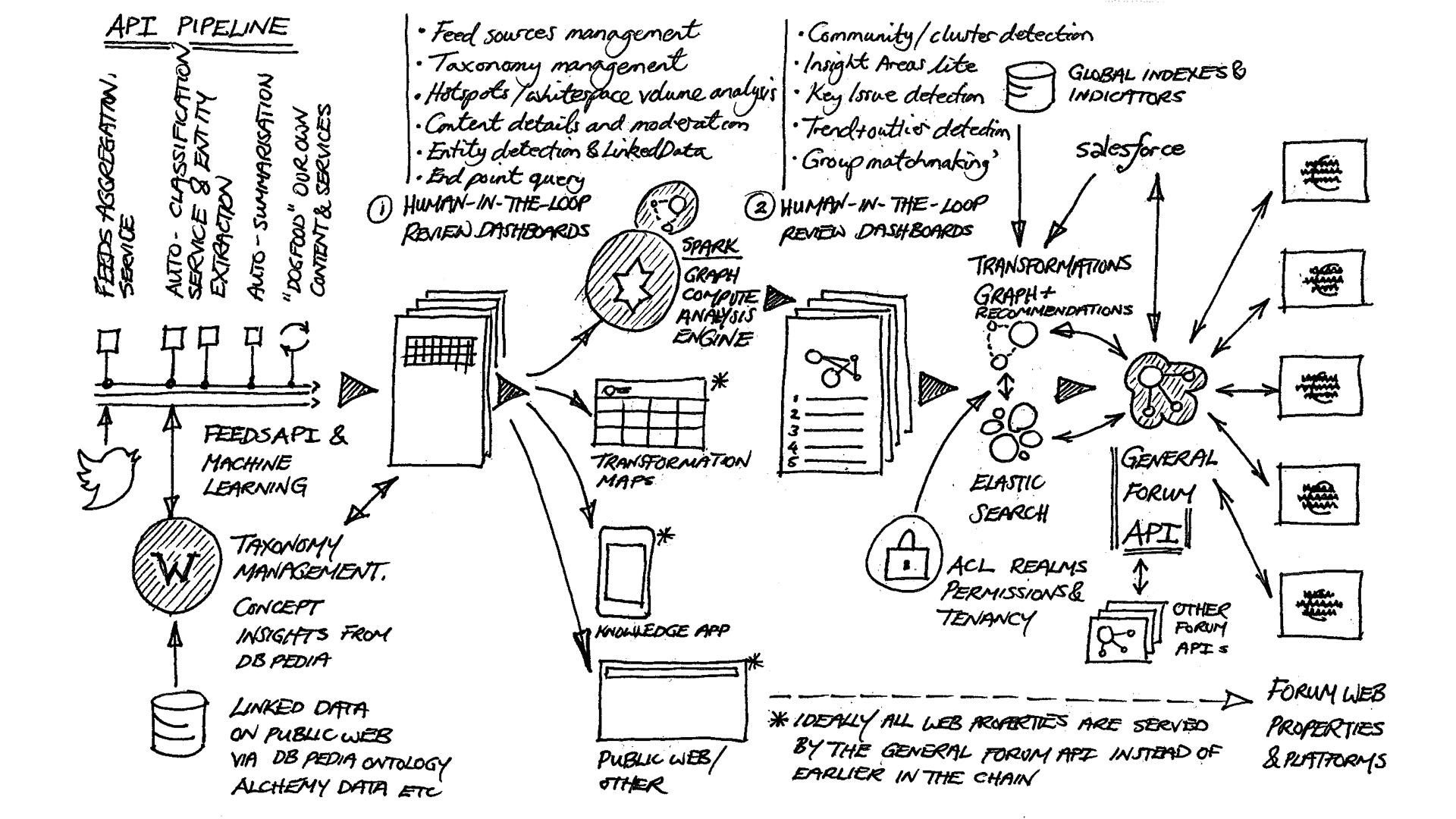We are moving into a deeply exciting age of ‘Intelligent Applications’. As cognitive computing gathers ground, heads of technology need to consider building ‘Cognition Management Platforms’ rather than Customer Relationship Management systems. So how to think about the new infrastructures that power them? What technologies are available? And how to resource for them?
What is an Intelligent Application?
There are a few key changes to smart systems, rapid insight into customers’ behaviour, or the Semantic Web. The main difference is that we are starting to model thinking. We are making services that perform grunt-work thinking for us. This impacts how we imagine and build our products of the future. There are six key opportunities playing out, right now:
- Graph database technologies that model and query knowledge in a way that is closer to how we think
- Breakthroughs in engineering and delivery of Artificial Intelligence, including Cognition-as-a-Service as consumer products
- Performance-focused next-generation infrastructures for Business, Graph, and real-time Transactional Analytics
- Insight-to-action feedback which includes Human-in-the-Loop judgment as a process step for product and algorithm improvement
- Rich customer and User Experiences that deliver context and personalization via intuitive interfaces
- A Multi-Model approach to product and systems design, bringing new technologies together into a hybrid infrastructure
An Intelligent Application built upon these innovations creates a change of mindset. A whole new way of thinking. These technologies allow us to design systems that model how an organization thinks. They allow us to present more than just the data of the product, service or customer relationship.
Modelling the speed of thought
There has been a lot of talk about big data and the holy grail of harnessing the 4 Vs: Volume, Variety, Velocity and Veracity. In parallel there have been somewhat philosophical discussions about when big data ‘is’ big data, and big for whom. What’s important is not whether data is
big, or streaming in real time. It is whether Big Data is usable at the speed of your organisation’s thought.
Capturing fraud within financial transactions requires real-time discovery of patterns in the data, with swift human-in-the-loop interception when a red flag requires a judgment call. At the other end of the scale, global trends analysis is often annual, as a gift to muse about over the Christmas period in the lead-up to a new year.
But as the world speeds up, this kind of ‘manual’ analysis will move into Intelligent Applications that provide insight to leaders at the speed of boardroom thought – perhaps for quarterly reporting or key strategy meetings. The insights will be delivered via next generation infrastructures, and the humans-in-the-loop are the analyst contributors and the members of the board.
The art of multi-model ricochet design
Many organizations have, on the surface, similar problems. A standard way to solve technology requirements has been to buy to enterprise products. A features checklist manages expectations, and a team of consultants build something pragmatic.
As the pressure for competitive advantage rises, so will the need for bespoke systems. What will increase insight or efficiency if you smaller or niche companies? What will you build, and why? This tension is visible at high-level tech and big data conferences. There is a flurry of camera phones every time a diagram pops up on the Powerpoint. Heads of IT seek models for how to imagine this new opportunity, and how to discuss with the heads of other departments.
Among the first steps are lean development. Cloud services with reduced overheads for DevOps. Machine Learning micro-services. Learning by doing and prototyping. A credit card and a few willing accomplices will go a long way to start.
Once an Intelligent Application shows enough promise to influence change within an organization, it can then receive wider input before getting hardened into a secure and reliable infrastructure.
Add to that some personal thinking tools. Become a ‘Design Thinker’. Model and graph the way your organization thinks and classifies its knowledge. What taxonomy of entities and data relationships defines the flow of ideas, analysis, and production in your organization? How does
senior decision-making get represented?
Then combine microservices into an ecosystem as a multi-model architecture. Companies like IBM are investing US$1 billion into their Watson division. They already have an incredible range of cloud services available to circumvent the talent shortage and the need for complex DevOps. There are many other suppliers with similar kinds of infrastructure offerings. The art is in defining which pre-created service, connected up to which other pre-created service, will deliver your desired results.
This is not only the design of a technology pipeline. It’s about picking, choosing, and joining together services from a variety of vendors. It’s also about building a ricochet of value between services in your multi-model architecture.
Imagine real-time streaming data using Spark, performing analysis to look for patterns in the data identified as relationships in your organizational Knowledge Graph. Then performing Machine Learning entity extraction to power a recommendations engine. The behavioral results are fed back and stored in the graph. This is augmentation between services. A 360-degree view of your customers’ needs evolves dramatically when you go bespoke in this way.
Rising to the Uber challenge
Most organisations don’t have the luxury of a huge IT department, nor sufficient internal talent to innovate the next Airbnb or Uber, regardless of how often company Directors wheel out this ideal. But that’s no reason not to use the underlying principles. And it’s not only about rapid, disruptive
innovation.
Uber and AirBnB have intuitive interfaces that deliver context and personalization via a rich customer and User Experience. The application has been perfectly simplified. The tasks being performed via the interface are streamlined. The focus of attention does not distract with irrelevant features or uncertainty over where to click next. Real-time features bring engaging, time-sensitive, or contextual information, such as a cab approaching. The mental model that users build up whilst interacting feels natural to the way they think without realizing it. Creating that takes time, and an attention to psychological detail.
Part of the Uber challenge is about the ‘front end’ of the application, the tip of the customer-focused iceberg. And if you’re not thinking that way on the front end, chances are you’re not thinking that way on the back end either. Bad data models, poor infrastructure inter-operability,
and terrible interfaces wreck productivity and analytical clarity.
Modeling how a user thinks on the front end is every bit as important as modeling how your organization thinks via the back end. How will your system do some thinking for you? The parity and complementary relationship between the two is itself a competitive advantage. It is an ethic that drives an organization. Intelligent Applications think like both the consumers and the underlying organization, together.
Cognition Management Platforms
So the biggest opportunity for creating Intelligent Applications is to imagine that you’re building a Cognition Management Platform that works across the entire organization, from front to backend.
For some time, processes have been modeled to enable efficiencies. Analysis can be modelled too. Think of each service as an outsourcing of grunt-work thinking, so that a team is liberated to perform at a higher level of value.
In the next wave of competitive advantage and Intelligent Applications, you will need more than data structure to create value. You need machines that can reason. You will have to describe to them what your view of the world looks like and what knowledge you have of it. You will need to teach computers to think and what to think about. You will need to tell them what conclusions they can draw for you, and when to hand the decisions over to a human.
Cognition Management Platforms will evolve beyond CRM to become an essential brain for your organization. One that may well have a dialogue with your clients, both with and without you.
This article was contributed to IDG Connect, on 14 March 2016, and has been edited for further clarity. Kamille Nixon commissioned it and collaborated on the themes, whilst at Neo technology the creators of the leading Graph Database Neo4j.

Scott David leads User Experience strategy and design at the World Economic Forum, across their digital platforms for data-driven knowledge and communities of global leadership.













